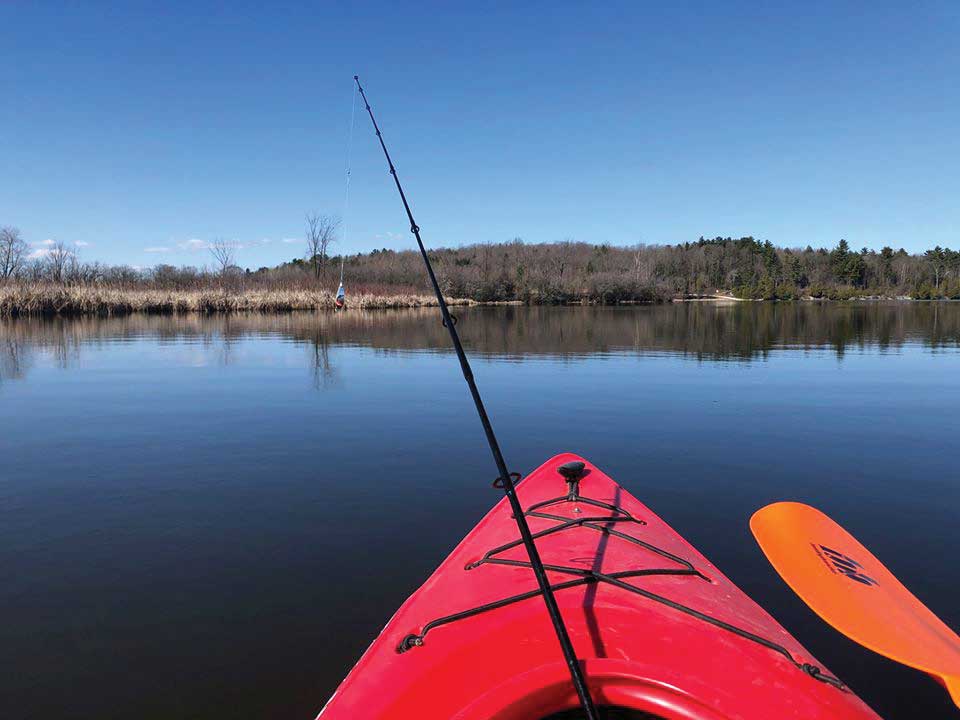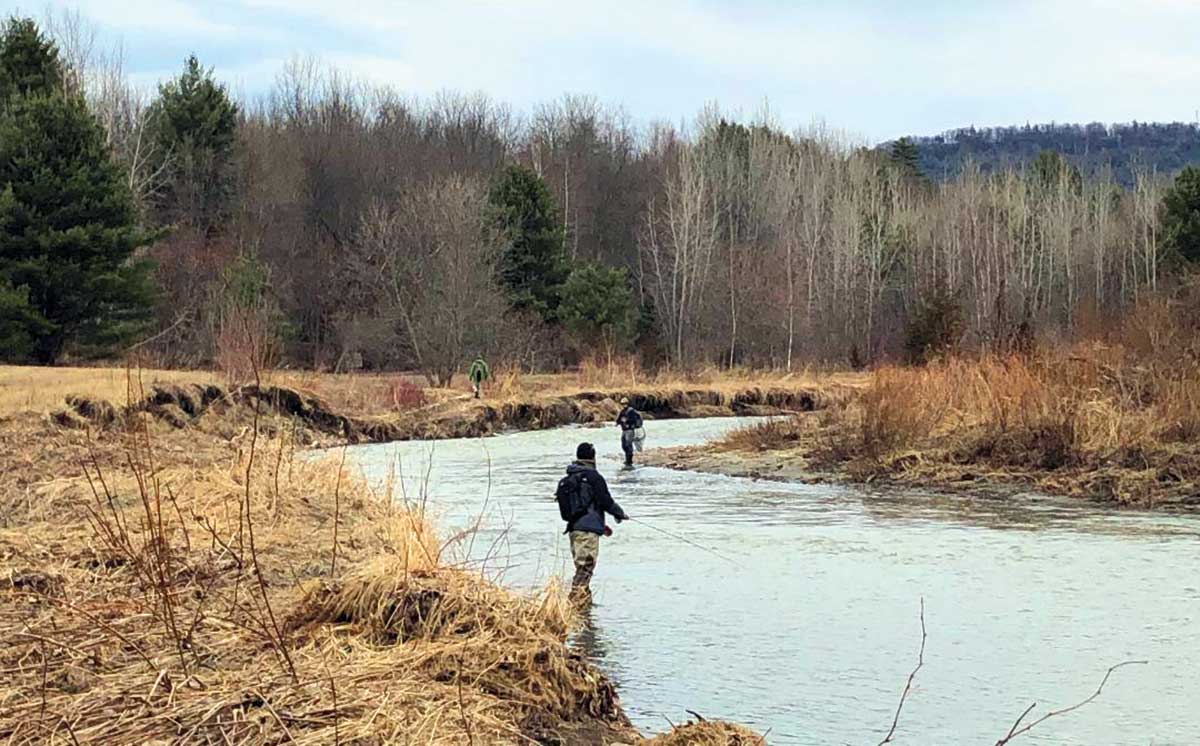Find an escape and stay socially-distanced while still wetting a line this summer.
I’ve been into fishing my whole life, and although I can’t recall the first time I ever went fishing, I also can’t think of a time when I didn’t. This is either testimony to my love of the sport or to my fading memory. Either way though, I have spent a hell of a lot of time on the water.
I lived in New York for 18 years, Massachusetts for 10, and in Vermont for almost all of the past 35 years. There was a 10-month stretch I spent in Florida, but it was only a brief detour that was corrected by my return to Vermont four years ago. During that hiatus down south though, I got out to fish over 100 times. A normal season for me in Vermont tends to be more like between 40 to 50 days, although during the time that I owned and operated a small guide service/fly fishing school during the late ‘80s and mid-‘90s, I hit the century mark a couple of times. The biggest difference in all of this was that while I did most of my fishing on the ocean when I lived in New York and Massachusetts, since I made Vermont my home, I’ve spent virtually all my time on freshwater instead.
But no matter what kind of water might have been available to me, I didn’t do very much fishing last year. In fact, between the 4th of July and sometime in late August, I went fishing zero, zip, zilch, no days at all. I had been on the road almost constantly during that period. But when I finally got home, I knew what I had to do.

Given that late August days tend to be on the warm side, even this close to the 45th parallel, I figured my best bet was to fish the outflow of a hydropower dam. Plenty of anglers curse the presence of dams, as they effectively block the migration of spawning fish. While this is true, they also create opportunities. At the very least, the rapidly-moving water running out from the bottom of the dam through the turbine tends to be heavily oxygenated and often a little cooler than the water directly upstream. This keeps fish healthy, comfortable and active.
It was beautiful the morning I went out, and in spite of the fact that I had a lot of work to do, I was very happy to blow it all off. It was mid-week and that meant that I was likely to have much, if not all of the river to myself. But when I got to the dam, I saw at least a dozen pickup trucks parked at the pullover. I initially wondered why so many gainfully employed people were ducking their responsibilities. I had assumed that I was the only one slothful enough to do that. It turned out that all of those trucks (and the crane that pulled in only a few minutes after I arrived, along with another six or seven pickups) were there to work. One of the guys on the crew wandered over to me. I gestured to two trucks that bore the logo of a commercial diving contractor.
“Fishing’s so good that you’re gonna snorkel for ‘em?” I quipped, although I was getting a sinking feeling in my gut.
“Yeah,” he replied with a thin smile. “We’ve got a couple guys down there with spear guns right now.”
We both looked at the dam. Water was pouring over the top, indicating a healthy river flow, but I noticed that there was nothing coming through the turbine. The guy explained that the power company was going to yank the old turbine out and replace it, a job that he figured would take the rest of the year to complete.
“I’ve got to start posting this whole area pretty soon” he continued. “It’s going to be too dangerous for folks to come in and fish until we’re finished.”
And that was the end of my first day of fishing in almost two months. I sometimes feel like the Rodney Dangerfield of this sport. By the end of November, I counted it out and realized that I had only fished 20 days in all of 2019! I couldn’t recall hitting a low like that even in 2011 and 2014, two years when I was laid up for several months recovering from surgeries. I spent all of this past winter then vowing that 2020 would reverse the downward trend of the previous season.
And of course, this has been a very strange year, what with us all being told to maintain social distance and to hunker down in the confines of our homes for many weeks. But you have to get out and a lot of folks I know did just that. Sure, it can be complicated sometimes to stay at least 6 feet away from each other, but anglers tend to be solitary souls anyway. Many I know jealously guard the water where they suspect fish might be living. Secrecy protects those spots and it doesn’t pay to fish too near others, for fear they will learn what you already know. But it’s also just plain polite to give folks a bit of a berth anyway. I on the other hand need the extra space to make sure that I don’t impale someone with whatever it is I’ve tied onto my line. I suppose though that this might be considered good manners too.
Most folks in the very northern part of our region don’t normally get out onto the water until sometime in April, but on March 26 this year, I got a text from a good friend who announced that he was going to hit one of the small streams near where I live to fish for steelhead trout. This was a bit of a commitment on John’s part as he would have to drive over an hour from where he lives to get to a piece of water that has, shall we say, a somewhat challenging slope that one must either hike or slide down to get from the road to its banks. In fact, in the early spring, after all of the snow melt and rainfall we normally see, it can be quite treacherous and the likelihood that you might fall flat on your butt is quite high. Still, he was determined and a few hours later, I received another text from him that read: “4 cars by the falls and 6 by the bridge.”

In short, every other angler who had been forced out of work by the order to shelter-in-place had come up with the same idea. That little stream that normally would be almost bereft of humans in March was packed like a pub might be at lunchtime on St. Patrick’s Day (well, except maybe for this past St. Patrick’s Day anyway).
A few hours later, I called John and we conferred on how to get outside, keep away from other anglers, and still get into some fish. The answer was devilishly simple: kayaks. With all of the open water available to us on the many lakes and ponds within a few miles of where we both live, we could fish and maintain social distancing all season long.
When I first took the kayak out this year, I couldn’t shake the image of the portraits of Elizabethan women in a hoop skirts, or “farthingales” as they were known back then. They allowed the young ladies of the time to maintain adequate social distance from the young men, but I had far from expected that paddling in my kayak would bring this thought to mind. It did though, which I suppose a licensed psychiatrist could say speaks to some bizarre repressed feelings I may have about my mother. I suppose that it’s also possible that it only referred to how awkward I felt that day, bobbing around on the surface of the pond while trying to keep my fishing lure out of the lower branches of the trees on shore.
Still, you can’t argue with the fact that a 12-foot kayak offers the angler a perfect way to get out on the water, while almost certainly guaranteeing that he or she won’t get within 6 feet of anyone else. The same can be said for a pair of anglers in a 16-foot canoe, so long as they are careful about loading and unloading their gear. You can even bring your dog along with you, if it’s the kind that will resist the urge to go racing around the hull, barking at everything it sees or hears. There’s no sense in everyone taking an unscheduled swim when your beast capsizes your craft and you are forced to spend the remainder of the day diving to retrieve your gear. I’ve fished in canoes and kayaks for decades and I have always loved silently working the shallows of small ponds in them, or trolling lazily in larger lakes. But who would ever have imagined that someday they might also be among the best tools for finding a badly needed escape from the great indoors during the uncertain times of a pandemic.



